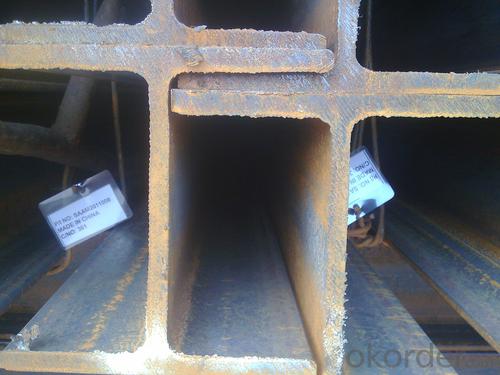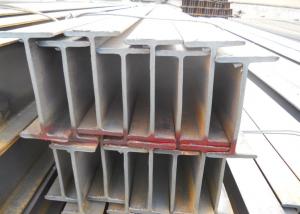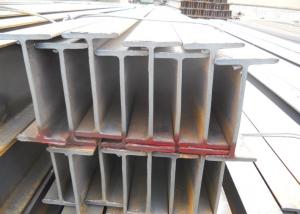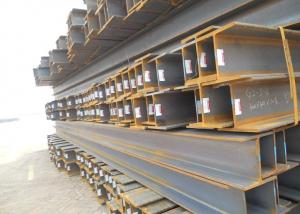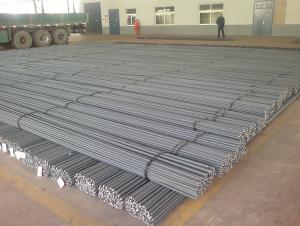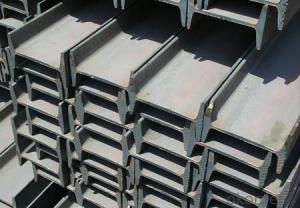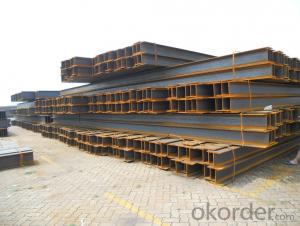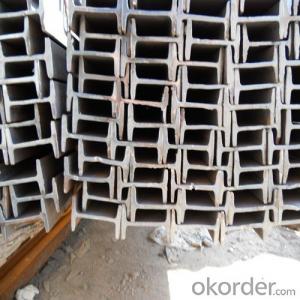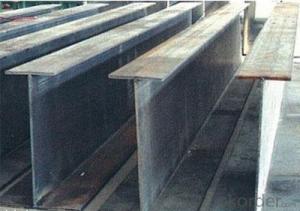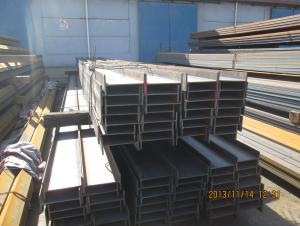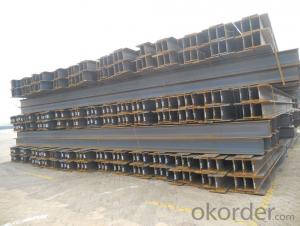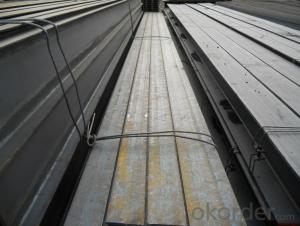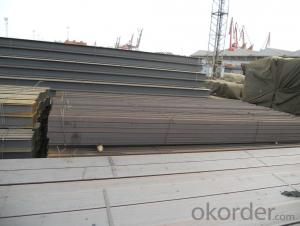JIS Structual Carbon Steel Hot Rolled H-beam Bar
- Loading Port:
- China main port
- Payment Terms:
- TT or LC
- Min Order Qty:
- 25 m.t.
- Supply Capability:
- 1000 m.t./month
OKorder Service Pledge
OKorder Financial Service
You Might Also Like
Product Description:
OKorder is offering high quality Hot Rolled Steel I-Beams at great prices with worldwide shipping. Our supplier is a world-class manufacturer of steel, with our products utilized the world over. OKorder annually supplies products to European, North American and Asian markets. We provide quotations within 24 hours of receiving an inquiry and guarantee competitive prices.
Product Applications:
Commercial building structure ;Pre-engineered buildings; Machinery support structure; Prefabricated structure; Medium scale bridges; Ship-building structure.etc.
Product Advantages:
OKorder's Steel I-Beams are durable, strong, and resist corrosion.
Main Product Features:
· Premium quality
· Prompt delivery & seaworthy packing (30 days after receiving deposit)
· Corrosion resistance
· Can be recycled and reused
· Mill test certification
· Professional Service
· Competitive pricing
Product Specifications:
Manufacture: Hot rolled
Grade: Q195 – 235
Length: 6m – 12m, as per customer request
Packaging: Export packing, nude packing, bundled
H x B
(mm)
| T1 | T2 | JIS Weight
(kg/m)
| GB Weight
(kg/m)
|
100*100 | 6 | 8 | 16.9 | 17.2 |
125*125 | 6.5 | 9 | 23.6 | 23.8 |
150*75 | 5 | 7 | 14 | 14.3 |
148*100 | 6 | 9 | 20.7 | 21.4 |
150*150 | 7 | 10 | 31.1 | 31.9 |
175*90 | 5 | 8 | 18 | 18.2 |
175*175 | 7.5 | 11 | 40.4 | 40.4 |
198*99 | 4.5 | 7 | 17.8 | 18.5 |
200*100 | 5.5 | 8 | 20.9 | 21.7 |
194*150 | 6 | 9 | 29.9 | 31.2 |
200*200 | 8 | 12 | 49.9 | 50.5 |
248*124 | 5 | 8 | 25.1 | 25.8 |
250*125 | 6 | 9 | 29 | 29.7 |
244*175 | 7 | 11 | 43.6 | 44.1 |
250*250 | 9 | 14 | 71.8 | 72.4 |
298*149 | 5.5 | 8 | 32 | 32.6 |
298*201 | 9 | 14 | 65.4 | |
300*150 | 6.5 | 9 | 36.7 | 37.3 |
294*200 | 8 | 12 | 55.8 | 57.3 |
300*300 | 10 | 15 | 93 | 94.5 |
346*174 | 6 | 9 | 41.2 | 41.8 |
350*175 | 7 | 11 | 49.4 | 50 |
340*250 | 9 | 14 | 78.1 | 79.7 |
350*350 | 12 | 19 | 135 | 137 |
400*200 | 8 | 13 | 65.4 | 66 |
390*300 | 10 | 16 | 105 | 107 |
400*400 | 13 | 21 | 172 | 172 |
446*199 | 8 | 12 | 65.1 | 66.7 |
450*200 | 9 | 14 | 77.9 | 79.5 |
440*300 | 11 | 18 | 121 | 124 |
496*199 | 9 | 14 | 77.9 | 79.5 |
500*200 | 10 | 16 | 88.2 | 89.6 |
488*300 | 11 | 18 | 125 | 129 |
596*199 | 10 | 15 | 92.5 | 95.1 |
600*200 | 11 | 17 | 103.4 | 106 |
588*300 | 12 | 20 | 147 | 151 |
700*300 | 13 | 24 | 182 | 185 |
800*300 | 14 | 26 | 207 | 210 |
900*300 | 16 | 28 | 240.1 | 243 |
FAQ:
Q1: Why buy Materials & Equipment from OKorder.com?
A1: All products offered byOKorder.com are carefully selected from China's most reliable manufacturing enterprises. Through its ISO certifications, OKorder.com adheres to the highest standards and a commitment to supply chain safety and customer satisfaction.
Q2: How do we guarantee the quality of our products?
A2: We have established an advanced quality management system which conducts strict quality tests at every step, from raw materials to the final product. At the same time, we provide extensive follow-up service assurances as required.
Q3: How soon can we receive the product after purchase?
A3: Within three days of placing an order, we will begin production. The specific shipping date is dependent upon international and government factors, but is typically 7 to 10 workdays.
Images:
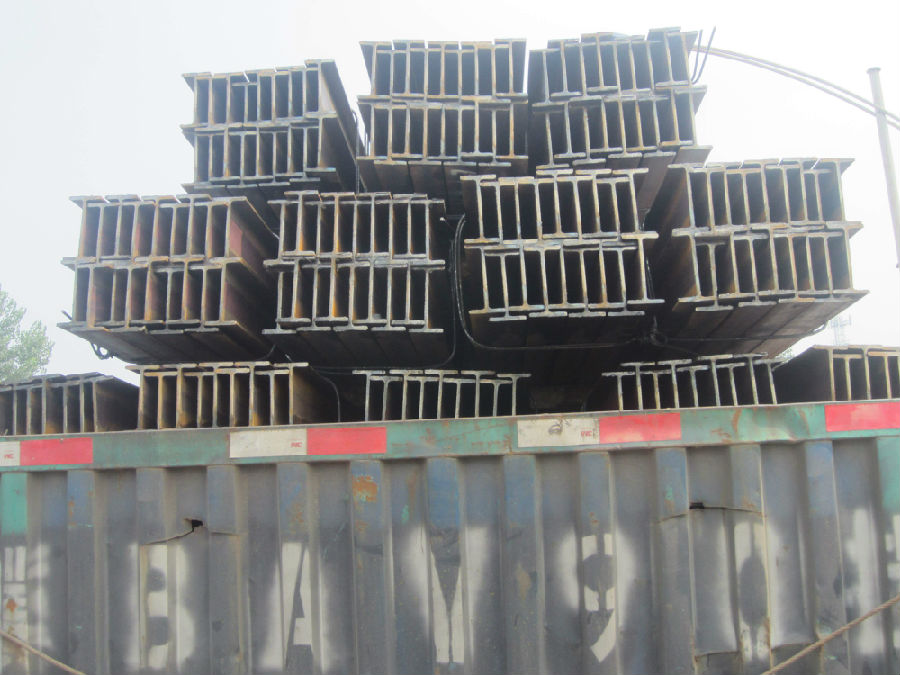
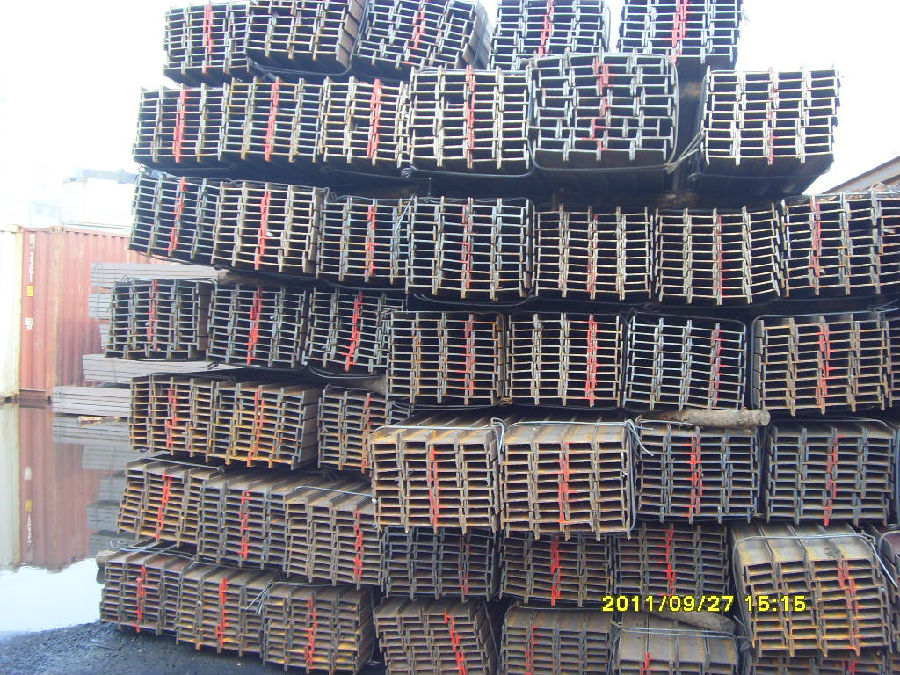
- Q: How do steel H-beams perform in terms of buckling resistance?
- Steel H-beams are known for their excellent buckling resistance. The H-shape provides a high moment of inertia, which means that the beam is less likely to buckle under compressive loads. The flanges of the H-beam help distribute the load evenly, reducing the risk of localized buckling. Additionally, the vertical web of the H-beam provides additional stiffness, further enhancing its resistance to buckling. Overall, steel H-beams are considered to be one of the most robust and reliable structural members, making them highly suitable for applications where buckling resistance is crucial.
- Q: What are the different welding techniques used for steel H-beams?
- The different welding techniques commonly used for steel H-beams include shielded metal arc welding (SMAW), gas metal arc welding (GMAW), flux-cored arc welding (FCAW), and submerged arc welding (SAW). Each technique has its own advantages and limitations, and the choice of technique depends on factors such as the type of steel, joint design, and project requirements.
- Q: Can steel H-beams be used in sports arena structures?
- Yes, steel H-beams can be used in sports arena structures. Steel H-beams are commonly used in construction due to their strength, durability, and versatility. They provide excellent structural support and can withstand heavy loads, making them suitable for large-scale projects like sports arenas.
- Q: What are the requirements for steel H-beams in areas with heavy snowfall?
- The requirements for steel H-beams in areas with heavy snowfall typically involve ensuring that the beams can withstand the increased load caused by the weight of the snow. This includes using higher strength steel grades, adequate beam sizes, and proper design calculations to accommodate the additional snow load. Additionally, appropriate corrosion protection measures should be taken to prevent any damage caused by the moisture in the snow. Regular inspections and maintenance are also crucial to ensure the beams remain in optimal condition under heavy snowfall conditions.
- Q: How do steel H-beams contribute to sustainable transportation infrastructure?
- Steel H-beams make significant contributions to sustainable transportation infrastructure in various ways: 1. Long-lasting: Steel H-beams possess exceptional durability, enabling them to withstand heavy loads and harsh weather conditions. Consequently, their lifespan surpasses that of alternative materials, reducing the need for frequent replacements. Consequently, there is a decrease in material waste and energy consumption associated with transportation infrastructure maintenance and repairs. 2. Cost-efficient: Due to their longevity and low maintenance requirements, steel H-beams are a cost-effective choice. By minimizing the need for repairs and replacements, they result in considerable cost savings over the lifetime of transportation infrastructure projects. This efficient allocation of resources promotes sustainable budget management. 3. Recyclability: Steel ranks among the most recycled materials globally, and H-beams made from steel can be easily recycled at the end of their life cycle. This not only reduces the demand for new steel production but also minimizes the environmental impact associated with extracting and manufacturing new materials. By utilizing recycled steel, transportation infrastructure projects contribute to a circular economy and reduce their carbon footprint. 4. Design adaptability: Steel H-beams offer engineers design flexibility, enabling the creation of efficient and innovative transportation infrastructure solutions. Their high strength-to-weight ratio allows for the construction of lighter structures, reducing overall material consumption and transportation costs during construction. Furthermore, their ability to span long distances without intermediate support pillars decreases the need for additional materials and land use, promoting environmental friendliness. 5. Resilience: Steel H-beams exhibit exceptional resistance to natural disasters like earthquakes and hurricanes. This resilience ensures the safety and stability of transportation infrastructure, reducing risks associated with major events. By minimizing damage caused by natural disasters, steel H-beams contribute to the sustainable functioning and longevity of transportation networks. In conclusion, steel H-beams play a crucial role in establishing sustainable transportation infrastructure by offering durability, cost-efficiency, recyclability, design adaptability, and resilience. By incorporating these beams into construction projects, we can enhance the longevity, safety, and environmental friendliness of transportation networks, thus contributing to a more sustainable future.
- Q: Can steel H-beams be used in wastewater treatment plant construction?
- Indeed, steel H-beams are applicable for construction in wastewater treatment plants. Their strength and durability render them a popular choice in the construction field. In the realm of wastewater treatment plants, these beams serve a multitude of structural purposes, including the support of heavy equipment, the formation of building frameworks, and the provision of load-bearing reinforcement for pipelines and ductwork. The corrosion-resistant properties of steel make it an ideal material for deployment in wastewater treatment plants, where exposure to water, chemicals, and other adverse environmental conditions is commonplace. Moreover, steel H-beams can be customized to meet specific design specifications, thereby establishing their versatility as a construction option within the wastewater treatment industry.
- Q: Are steel H-beams resistant to corrosion?
- Steel H-beams generally exhibit resistance to corrosion. Steel, a highly durable and adaptable material, possesses the ability to withstand exposure to weather conditions and various environmental factors. However, the degree of corrosion resistance may vary depending on the specific steel type utilized and the presence of protective coatings. When it comes to H-beams crafted from carbon steel, their susceptibility to corrosion increases, particularly in humid or corrosive surroundings. To bolster their resistance against corrosion, H-beams can undergo processes like galvanization or application of protective layers such as paint or epoxy. These coatings function as a barrier, effectively hindering moisture and other corrosive elements from reaching the steel surface. Consistent maintenance and proper care are also vital in preserving the corrosion resistance of steel H-beams over time.
- Q: How do steel H-beams perform in vibration-prone environments?
- Steel H-beams have gained a reputation for their exceptional performance in environments prone to vibrations. The distinctive design of H-beams, characterized by their wide flanges and vertical web, grants them superior rigidity and strength, resulting in a high resistance to vibrations. This structural shape effectively distributes the load evenly, minimizing the impact of vibrations on the beam. The utilization of steel as the material for H-beams ensures remarkable durability and stability, making them especially suitable for environments where vibrations are prevalent. Steel possesses a high modulus of elasticity, enabling it to endure and absorb vibrations without experiencing significant deformation or damage. This property establishes steel H-beams as a dependable choice for structures exposed to dynamic loads, including bridges, high-rise buildings, and industrial facilities. Moreover, steel H-beams can be customized with additional measures to enhance their performance in vibration-prone environments. These measures encompass options such as thicker flanges, increased beam depth, or the inclusion of damping materials. By implementing these measures, the H-beams can further mitigate vibrations and minimize their impact on the overall structure. In conclusion, the inherent strength, rigidity, and durability of steel H-beams make them well-suited for environments susceptible to vibrations. Their distinctive design and properties empower them to endure vibrations without compromising the stability of the structure. When appropriately designed and executed, steel H-beams offer a reliable and efficient solution for structures that must excel in such challenging conditions.
- Q: Can steel H-beams be used in retrofitting existing buildings?
- Yes, steel H-beams can be used in retrofitting existing buildings. These beams are commonly used in structural reinforcement projects as they provide excellent strength and load-bearing capacity. They can be installed to reinforce and strengthen existing structural elements, such as walls, floors, or roofs, to enhance the overall stability and durability of the building. Steel H-beams offer versatility and are an efficient choice for retrofitting projects.
- Q: What's the difference between I-beam and H steel?
- H section steel is a kind of economical and economical cutting surface profile (other cold bending thin wall steel, pressed steel plate, etc.). Because of the reasonable cross-section shape, they can make steel more effective and improve the bearing capacity. Unlike ordinary I-beam, the flange of H steel is widened, and the inner and outer surfaces are usually parallel so that it is easy to connect with high strength bolts and other components. Its size constitutes a reasonable series, complete model, easy to design and use. (in addition to crane girders)
Send your message to us
JIS Structual Carbon Steel Hot Rolled H-beam Bar
- Loading Port:
- China main port
- Payment Terms:
- TT or LC
- Min Order Qty:
- 25 m.t.
- Supply Capability:
- 1000 m.t./month
OKorder Service Pledge
OKorder Financial Service
Similar products
Hot products
Hot Searches
Related keywords




